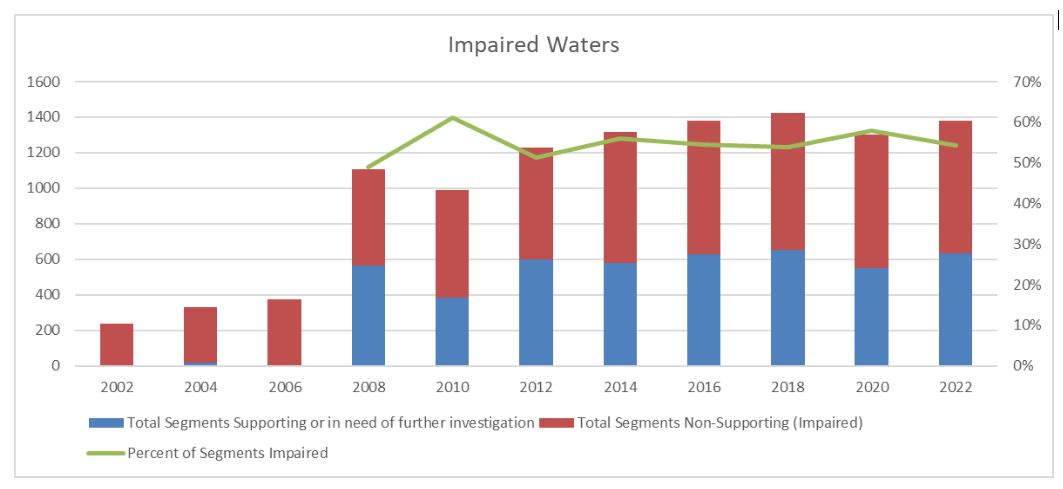2022 Impaired Waters List in Iowa: Concerning Trends Continue
posted
on Tuesday, February 22, 2022
in
Water and Land News
Des Moines, IA – The Iowa Department of Natural Resources (IDNR) released the draft 2022 303(d) Impaired Waters List for the state of Iowa on Thursday, February 17. The report, required by the Clean Water Act to be completed on April 1 of even-numbered years, is a compilation of data spanning a five-year window of 2016-2020.
The report finds that of the waters tested by IDNR staff for the 2022 report, 54% have impairments. “It’s unacceptable that more than half of the streams, lakes, and rivers in Iowa aren’t suitable for at least one intended activity, whether that’s swimming, fishing, or drinking,” said Alicia Vasto, Water Program Associate Director with the statewide non-profit Iowa Environmental Council. “Iowans are losing more and more access to their precious natural resources every year.”
The 2022 report lists 1,382 waterbody segments assessed with 751 of those segments impaired. That compares to 1,300 segments assessed with 752 segments impaired in 2020, and 1,422 segments assessed with 767 segments impaired in 2018.

Impairments can include E.coli bacteria (an indicator bacteria that typically means other pathogens are present), turbidity (water clarity), pH, fish kills, or algae. When a waterbody is added to the Impaired Waters List, the state is required to prepare a total maximum daily load, or TMDL. The TMDL identifies the causes of the impairment. Iowa DNR typically includes the TMDL in a Water Quality Improvement Plan, which outlines how the waterbody can be protected and improved to eventually meet its intended use. Waterbodies are categorized for an ‘intended use,’ such as a drinking water source, recreation, or other needs.
DNR reported that 48 impairments are being proposed for delisting from 2020 report. The primary reason for delisting is new data showing water quality improvement (30 impairments). Other impairments are proposed for delisting because a TMDL was prepared and approved (6) and new data showing the recovery of a biological community was collected (5).
“The 2022 report shows an increase in the number of waterbodies assessed and a slight decrease in the percent of segments impaired,” said Vasto. “However, the trend going back to 2010 shows that more than half of the assessed waters are impaired. That has not changed.”
“This report shows once again that we’re holding a status quo on poor water quality in Iowa,” said Ingrid Gronstal, Water Program Director with the Iowa Environmental Council. “State policy relies on voluntary measures to address water quality, and we have seen time and again that improvements are not being made at the pace and scale necessary to address Iowa’s water quality problems.” IEC continues to call for increased resources accountability for water quality improvement in the state, request that the state implement numeric criteria for nutrient pollution, and have the tools and resources to enforce those measures.
"The current system of voluntary compliance isn’t working, and it is a disservice to communities across the state. It’s time to make mandatory requirements while still advocating for flexibility for individuals to meet the required measures,” said Michael Schmidt, Staff Attorney with IEC.
Iowans are encouraged to read the report, review a searchable database of waterbodies on the list, or view an interactive map at https://programs.iowadnr.gov/adbnet/Assessments/Summary/2022/Impaired/Map
Public comments are due to the Iowa DNR at IRcomment@dnr.iowa.gov by March 19, 2022.
Comments can also be mailed to:
Iowa Department of Natural Resources
Attention: IR Comments
Water Quality Monitoring & Assessment Section
Wallace State Office Building
502 East 9th Street
Des Moines, IA 50319
- clean water
- dnr
- harmful algal blooms
- nitrate pollution
- phosphorus pollution
- toxic algae
- water quality
- water recreation